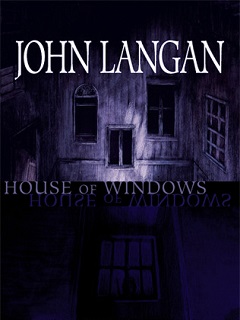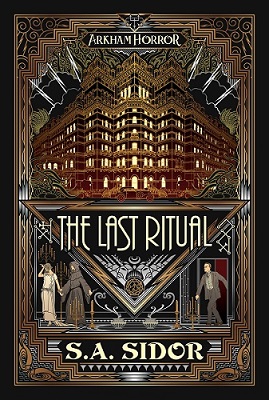 Dark Blood Comes from the Feet is an excellent debut short story collection. Author Emma J. Gibbon fills her book with an eclectic and fun mix of tales. Horror fans will find a diverse group of subgenres represented within the pages and will be delighted to encounter Body Horror, Vampires, Witches, Haunted Houses, Urban Legends, Monsters, and more. Each tale is short but leaves a memorable impression. I tried to make a list of my favorite stories in this book and realized I’d nearly written down the entire table of contents. When I paired that first list down, I was left with St. Scholastica’s Home for Children of the Sea, Black Shuck Tavern, Cellar Door, The Tale of Bobby Red Eyes, Janine, and This is Not the Glutton Club, but what your favorites are will depend on what horror subgenres you prefer. The prose is also wonderful throughout, and I had an effortless time moving through this book. I can’t wait to see what Gibbon does next.
Dark Blood Comes from the Feet is an excellent debut short story collection. Author Emma J. Gibbon fills her book with an eclectic and fun mix of tales. Horror fans will find a diverse group of subgenres represented within the pages and will be delighted to encounter Body Horror, Vampires, Witches, Haunted Houses, Urban Legends, Monsters, and more. Each tale is short but leaves a memorable impression. I tried to make a list of my favorite stories in this book and realized I’d nearly written down the entire table of contents. When I paired that first list down, I was left with St. Scholastica’s Home for Children of the Sea, Black Shuck Tavern, Cellar Door, The Tale of Bobby Red Eyes, Janine, and This is Not the Glutton Club, but what your favorites are will depend on what horror subgenres you prefer. The prose is also wonderful throughout, and I had an effortless time moving through this book. I can’t wait to see what Gibbon does next.
Category: Reviews
House of Windows
If you like a spooky story woven through with themes of fatherhood, references to Charles Dickens, and the occasional eruption of Hellraiser-like aesthetics, then House of Windows is the novel for you. John Langan is one of my favorite authors, and I was delighted to get a copy of his first book, House of Windows, from my wife for Christmas. This novel did not disappoint my high expectations.
Spoilers Below
Much like Langan’s other work, House of Windows contains a kind of Russian Nesting Doll narrative. On the top level, there is Veronica telling a horror writer the story of how her husband disappeared. The level below that is Veronica’s tale itself, and within that level, there are several digressions into other sub-levels. Some of these sub-levels are about Belvedere House, the spooky home that plays a major part of the tale, and others are backstory related to Veronica or her husband’s history. Each piece fits perfectly into the tapestry of House of Windows.
 While House of Windows seems like a haunted house story at first glance, it’s actually more of a haunted father story. The novel’s primary conflict stems from a curse that Veronica’s husband, Roger, places on his son, Ted. Roger places the curse on Ted after the two get into a physical fight over the fact that Roger left Ted’s mother to marry Veronica, his college student. Due to Ted’s death soon after the curse, Roger is unable to reconcile with his son, and Veronica is soon haunted by visions and reminders of Ted, figuratively and literally. Ted’s death breaks Roger, and to try to be closer to his lost son, Roger decides to move him and Veronica into the home where he raised Ted, Belvedere House. Once in Belvedere House, Roger becomes increasingly obsessed with his lost son’s death, and Ted’s haunting of Veronica gets progressively more intense until the novel’s climax, where Roger disappears during a supernatural event. There’s a lot I’m leaving out, but that’s the bare-bones summary of the book.
While House of Windows seems like a haunted house story at first glance, it’s actually more of a haunted father story. The novel’s primary conflict stems from a curse that Veronica’s husband, Roger, places on his son, Ted. Roger places the curse on Ted after the two get into a physical fight over the fact that Roger left Ted’s mother to marry Veronica, his college student. Due to Ted’s death soon after the curse, Roger is unable to reconcile with his son, and Veronica is soon haunted by visions and reminders of Ted, figuratively and literally. Ted’s death breaks Roger, and to try to be closer to his lost son, Roger decides to move him and Veronica into the home where he raised Ted, Belvedere House. Once in Belvedere House, Roger becomes increasingly obsessed with his lost son’s death, and Ted’s haunting of Veronica gets progressively more intense until the novel’s climax, where Roger disappears during a supernatural event. There’s a lot I’m leaving out, but that’s the bare-bones summary of the book.
Having just completed my own house hunt, and thinking an awful lot about fatherhood these days, made House of Windows the perfect novel for me to read this month. I was enthralled by the history of Belvedere House, which is implied to have contributed to and empowered Ted’s haunting, and I was attuned to the cycles of trauma Langan illustrated with Roger and Ted’s relationship. I was also fascinated by Langan’s craft choices in House of Windows. Most of the novel is told in two long sections without chapter breaks. This is done to reflect Veronica telling her tale in long narrations over the course of two nights. I thought this was a clever choice, and I found myself turning the pages quicker because of the lack of interruption.
House of Windows is an excellent read, with a ton of moments that will please horror genre fans as well as insights into the human condition that will please literary genre fans. Langan excels at balancing these two group’s expectations in his work. While I felt that his second novel, The Fisherman, leaned more toward the horror side of the genre seesaw, House of Windows leans a little more to the literary side. Regardless of which side of the genre seesaw you prefer to sit on, House of Windows is worth your time.
P.S.
If you like John Langan’s work as much as I do, you might be interested in checking out my reviews of The Fisherman, The Wide Carnivorous Sky, or Sefira.
The Last Ritual
The Last Ritual by S.A. Sidor is a perfect tie-in novel for the Arkham Horror Universe. It’s a fun, easy read that will leave you satisfied and ready to move onto your next Aconyte Books release. Each chapter is perfectly paced, with a cliff hanger to pull you into the next section. I highly recommend The Last Ritual for fans of the Arkham Horror games and Lovecraft’s Cthulhu Mythos. I thought I’d offer my summarized thoughts before I opened the gate to my full review. Consider this your last warning, spoilers will appear out of the cosmic abyss below.
 I was initially interested in The Last Ritual for two reasons. First, it was set in the Arkham Horror Universe. Anyone who knows me is aware I’m obsessed with Fantasy Flight’s Arkham Horror games. I most recently discussed my love for these games when I unboxed two recent products in a YouTube video, but I also wrote an essay called The Narrative Appeal of Board Games, which mentions Arkham Horror, a while back. For those new to the Arkham Horror Universe, it started with a single board game based on the Cthulhu Mythos, which later grew tentacles and birthed several other board games, card games, and video games. This isn’t the only tie-in fiction either. There are a few other novels and novellas, and I own a book called The Investigators of Arkham Horror, which details all the characters in the Arkham Horror Universe up to that point. The second thing that interested me about The Last Ritual was the flat-out gorgeous cover created by John Coulthart (pictured to the left). I can’t say enough about how quickly this work of art grabbed my attention, conveyed everything I wanted to know about the tale, and made me want to read this book.
I was initially interested in The Last Ritual for two reasons. First, it was set in the Arkham Horror Universe. Anyone who knows me is aware I’m obsessed with Fantasy Flight’s Arkham Horror games. I most recently discussed my love for these games when I unboxed two recent products in a YouTube video, but I also wrote an essay called The Narrative Appeal of Board Games, which mentions Arkham Horror, a while back. For those new to the Arkham Horror Universe, it started with a single board game based on the Cthulhu Mythos, which later grew tentacles and birthed several other board games, card games, and video games. This isn’t the only tie-in fiction either. There are a few other novels and novellas, and I own a book called The Investigators of Arkham Horror, which details all the characters in the Arkham Horror Universe up to that point. The second thing that interested me about The Last Ritual was the flat-out gorgeous cover created by John Coulthart (pictured to the left). I can’t say enough about how quickly this work of art grabbed my attention, conveyed everything I wanted to know about the tale, and made me want to read this book.
Of course, a good setting and façade aren’t worth much without a solid story inside. Thankfully, S.A. Sidor delivers a fantastic yarn. The narrative follows Alden Oakes, a painter, as he teams with Nina Tarrington, a writer, to investigate a mysterious artist’s commune called the New Colony. The pair suspects the New Colony is behind a series of ritualistic murders taking place around Arkham. A famed surrealist painter named Juan Hugo Balthazarr leads the artist’s commune, and he starts to take an increasingly dangerous liking to both Alden and Nina. The story combines elements of the Cthulhu Mythos with the work of F. Scott Fitzgerald, whose story “The Rich Boy” is quoted in the opening pages of this novel. Fans of the Arkham Horror Universe will be happy to know that Preston Fairmont, Calvin Wright, and Norman Withers make appearances in the prose, and there are also references to Carl Sanford and the Silver Twilight Lodge. The narrative flows beautifully toward its conclusion, which reminded me somewhat of the chilling end to John Carpenter’s Prince of Darkness, but I’ll leave the specifics for you to discover.
Lastly, as a fan and writer, I love finding additional connections between the various works set in the Arkham Horror Universe. I suspect that Juan Hugo Balthazarr mentioned his film director friend, Luis Bunuel, near the end of The Last Ritual to foreshadow the antagonist in Rosemary Jones’s Mask of Silver. To find out if I was right, I plan to buy Mask of Silver, the next book in this new series of Arkham Horror tie-in fiction, immediately.









